|
|
|
Monasteries in Leh |
|
|
Leh
Monasteries
A typical character of the monasteries is that each
monastery has a courtyard where main rituals in
gathering are performed or yearly festivals are
celebrated. The walls of stones which are inscribed with
prayers and religious figures are called Mani walls. On
the outer walls one can notice the lines of ‘prayer
wheels’. Prayer wheels are wood and metal cylinders with
prayers written on the long pieces of paper inside.
Every rotation of teach cylinder is equated to prayers
written on the paper and are sent to Buddha. This is the
reason that the pilgrimage keep on rotating the
cylinders. There are also many Stupas, known as Chortens.
Stupas are shrines containing relics of some religious
significance. Small prayer wheels can also be bought as
souvenirs in the shops. All religious instrument are
sacred and are to be taken care with respect. Mostly
inside the monasteries, the walls are decorated with
paintings and |
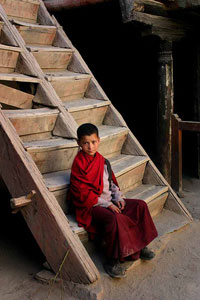 |
|
|
Thangkas and some of the
monasteries also have a collection of precious
manuscripts, many statues of Buddha as well as musical
instruments and colorful masks which are used for ceremonies
and at the time of festivals. Every monastery has many prayer
flags on which prayers are written and they are fixed
horizontal or vertical so that they have maximum exposure to
wind and flatter at every blow of wind. The flags flattered by
the wind, multiplied by the time prayers are written on them,
are conveyed to Lord Buddha. These flags also pay an important
role for the outer decoration of a monastery and create the
religious atmosphere. In Leh, monasteries may be either of the
Mahayana or the Hinayana sect of Buddhism. The monasteries are
traditional centers of culture, religious activities and
power. The head lama is called a 'kushak', meaning
reincarnation. The monasteries give the region its unique
flavor and beauty. Typically, most gompas are built so that
they perch precariously on lone rocks or craggy
mountain-faces. The monasteries also owe big lands. The
monasteries in Leh earlier depended only on the donations from
the villagers. Now most of them are charging a small amount as
entry fee which is used for the maintenance and restoration
work. The visitor should keep in mind that they are not
visiting a museum but a religious place. Visitors are expected
to wear dresses that do not expose their body too much.
Visitors should remove their shoes before entering the
monastery and should not eat, drink or smoke. The mural,
paintings and other religious objects and decorative parts
should not be touched. One should photograph only if this is
allowed as per the guidelines (like avoid flashlights). The
most visited monasteries in Leh are Shey, Thiksey, Hemis and
Spituk. Other magnificent Gompas located near Leh are the
Alchi, Lamayuru, Likir, Phyang, Rizdong, Stakna, Matho and
Chemery. All these Gompas are easily accessible from Leh.
|
|
|
|
Lamayuru Monastery
On the way from Kargil to Leh, you will visit the Lamayuru
monastery, one of the mysterious and the oldest monastery of
Ladakh. The Lamayuru monastery is situated about 10 kms from
Leh, on a big rock overlooking the Indus River. This monastery
was founded in the 10th century. According to the legends,
Lamayuru was a lake. It was blessed by a Lama after which the
water of the lake receded up to the mountains leaving place
for the monastery to be built. It is believed that one of the
great Tibetan teachers, Norapa, meditated here for several
years. Like all other Ladakh monasteries, it is also a complex
of buildings with shrines dedicated to different gods and
incarnations of Lord Buddha. |
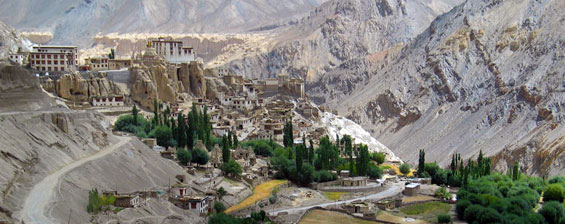 |
|
The complex, thought to be
the oldest in the region, was founded in the 11th century and
belongs to the Tibetan Kagyupa sect. It was partly destroyed
in the 19th century. Some of the murals, however, which are a
combination of Indian and Tibetan styles have been preserved.
The main hall of this monastery is very impressive and houses
numerous Thangkas and is worth a visiting place. There are
caves carved out of the mountain wall and some of the rooms
are richly furnished with carpets, Tibetan tables and butter
lamps. Also known as Yung Drung (Swastika) it is sited on a
high hill overlooking the village and valley. For sheer
spectacle value no other gompa can match Lamayuru. The
Yundrung Kabgyad festival is held during summer on the 28th
and 29th days of the 2nd Tibetan month. |
|
|
|
Alchi
Monastery
The village of Alchi is situated around 70 kms. from Leh
on the left banks of the Indus river. The village Alchi
differentiate itself from other villages of Ladakh by
being so lush green. The flood plain at Alchi is very
fertile and provides good and relatively extensive
agricultural land. Now most of the small houses are made
of bricks. The main road at both side is covered by the
Apricot trees. It is a normal sight to see the donkeys
(Mules) laden with wares and building material during
the summers when all the activities are at their peak.
The Alchi region too received cultural influence from
other areas. Alchi had contacts with Buddhism, Islam and
Hinduism, however the Alchi’s isolation helped the
village and the Gompa to keep their culture and
traditions intact. Alchi was also on the main trade
route of central Asia. The route along the Indus via Leh
was connected to the Chinese Turkestan.
The main centre of
attraction in the Alchi village is the |
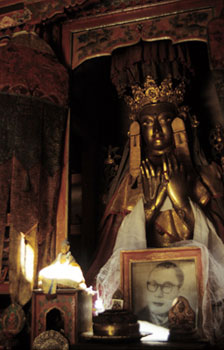 |
|
|
Alchi Gompa (monastery and
temple complex), on the banks of the Indus river. Alchi is
regarded as one of the most important Buddhist centers in
Ladakh and also as the monastic jewels of Ladakh. The Alchi
monastery dates back to nearly one thousand years and so the
effect of the Tibetan influence can be seen in the local
culture. There are five shrines in the Choskor temple complex
which has some splendid wall paintings. One of its walls
features thousands of miniature sized pictures of the Buddha.
Three large sized images made of clay painted brightly are its
focal attraction. No longer an active religious center, it is
looked after by monks from the Likir monastery. Since last 500
years, the religion is not practiced in the Alchi monastery.
Over a period of time the Yellow hat sect (Gelugpa) shifted
the religious activities to another place which is 30 kms
away, known as Likir. The surrounding of the Gompa offers a
very friendly atmosphere for the visitors as there are small
restaurants, tea stalls and as well as souvenir shops
welcoming the tourists. The visitors who have a very less time
to visit Leh can have an excursion to the Alchi monastery.
How to reach Alchi:
By Air:
The nearest airport is located at Leh, about 70 km from Alchi.
By Road:
Alchi is situated about 541 km from Manali and 364 km from
Srinagar.
Where to stay in Alchi:
During peak season, some of the guesthouses operate in Alchi.
Alternatively, accommodation can also be booked in Leh. |
|
|
|
Hemis
Monastery
The monastery of Hemis is situated on a green hill,
surrounded by spectacular mountains. Hemis is situated
around 45 kms in the south of Leh on the west banks of
the Indus river. The Hemis monastery is the biggest and
very richly endowed monastery of Ladakh. The Hemis
monastery was built in 1630. It belongs to the red sect,
Brokpa. It is not visible from the road as it is located
in a side valley. Impressive and intriguing, Hemis is
different from the other important monasteries of Ladakh.
The monastery is decorated on all the four
|
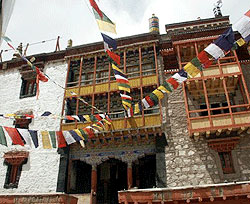 |
|
|
sides by the colourful
prayer flags which flutter in the breeze and send the prayers
to Lord Buddha. The main building has white walls. The
entrance to the complex is through a big gate which reaches to
a big courtyard. The stones of the walls are decorated and
also painted with the religious figures. On the north side
there are two assembly halls which are accessed by the stairs.
As in most of the monasteries one can also see here the
guardian deities and the Wheel of Life. Both of them are in
good condition. The Hemis monastery also has an important
library of Tibetan styles books and a very impressive and
valuable collection of Thangkas, gold statues and Stupas
embedded with precious stones. One of the largest Thangkas is
also displayed every 11 year during the festival time. The
annual festival, commemorating the birth anniversary of Guru
Padmasambhava, is held for two days in June-July, enlivening
the courtyard of the monastery. The festival of dances, where
good triumphs over evil in a colourful pageant, is also the
annual 'bazaar' where Ladakhis from remote areas buy and sell
wares. During the festival time, various rituals and mask
dances are performed in this courtyard. Hemis can be visited
from Leh comfortably in one day if one is traveling by car or
jeep. |
|
|
|
Phyang
Monastery
The Phyang monastery is located around 6 km away from
the Srinagar-Leh highway and around 20 kms. from Leh,
the capital of Ladakh. The Phyang Gompa (Monastery) is a
traditional monastery of Ladakh and is famous for its
spectacular religious festival with masked dances. This
monastery being on the hilltop resembles quite like the
monastery of Likir. The Phyang Monastery was built in
the 16th century and belongs to the Red Cap sect. The
festival of Phyang is called Tseruk' and falls on the
2nd and 3rd |
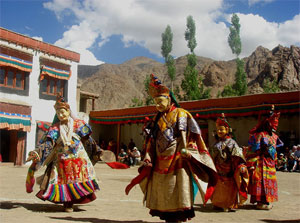 |
|
|
day of the 6th month of
Tibetan Calendar. The Phyang Monastery was the first
monastery, which introduced the Degungpa teaching of 'Skyob
Jigsten Gonbo' in Ladakh. These teaching were introduced by
Chosje Danma Kunga, during 16th century AD as King Jamyang
Namgyal ruled. Another attraction of Phyang is the museum.
This ancient 900 years old museum has a spectacular collection
of Chinese, Tibetan and Mongolian articles including fire arms
and weapons. After a recent renovation the monastery is worth
visiting. Travellers can also make a visit to the Phyang lake
just a few kilometers away. |
|
|
|
Shey
Monastery
Shey is the oldest capital of Ladakh from where its
earliest Tibetan kings ruled. The Monastery or Gompa of
Shey is located ideally on a high rock about 15 kms.
south of Leh on the eastern banks of the Indus river.
Until the 16th century, Shey was the residence of the
royal family. It was constructed by the first king of
Ladakh, Lhachen Palgyigon. According to tradition, it
was the seat of power of the pre-Tibetan |
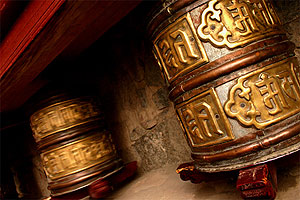 |
|
|
kings. One of the attraction
of the Shey is the victory stupa which is topped with gold. As
there was attack from the Dogra military the royal family
moved to Stock in order to escape. Much of the palace and fort
have fallen into ruins. But on the eastern side there are
extensive grounds with a large number of chortens. The Gompa
of Shey along with Thikse is regarded as an auspicious place
for cremation. The palace Gompa has a two storied 12 metre
high gold statue of Maitreya Buddha (Buddha of future) which
was commissioned by Senge Namgyal, sitting in meditation
posture and brilliantly coloured murals. This figure is made
of copper and brass and glided and studded richly with
precious gem stones. Shey is the oldest of the three
monasteries but at the same time it is not being used regularly
and therefore opens only till nine in the morning. It is
advised to leave early from Leh to visit the Shey monastery.
Above and below are the almost ruined walls of the old summer
capital of Ladakh. The Shey Palace was also the summer palace
of the former Raja of Leh. The palace museum of the Shey has
collection of beautiful royal costumes and jewellery, rare
Thangkas (Thangkas are religious themes and icons painted and
embroidered on cloth), porcelain, jade, weapons and armoury.
On the 30th day of the 1st Tibetan month Shey celebrates Shey
rul-lo and on the 10th day of the 7th Tibetan month, the Shey
Surb-lo is held. |
|
|
|
Spituk
Monastery
Spituk is yet another interesting monastery, on the hill
top near Indus about 18 kms. from Leh on Srinagar road.
The Spituk monastery offers a commanding view of Indus.
It has a totally new Gompa within the monastery as well
as the old Gompa has also been restored meanwhile. It is
constructed in a series of tiers with courtyards and
steps. Higher up in the hill is a chamber which houses
the enormous statue of goddess. Its face is covered and
uncovered only once in a year during the festival time.
|
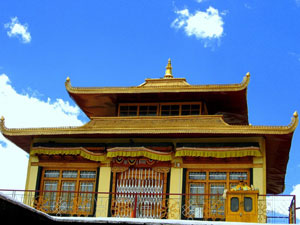 |
|
|
The Spituk Gompa was founded
in 11th century by Od-De, the elder brother of Lha Lama
Changchub-od. The Gompa was named Spituk (exemplary) by
Rinchen Zangpo, a translator came to that place and said that
exemplary religious community would rise. Initially the Gompa
was run according to the Kadampa school then during the reign
of king Gragspa Bumide he converted it to Gayluk Pa order.
Many icons of Buddha and 5 thangkas can be visited in this
15th century monastery. The Dukhang Hall is the largest
building and has two rows of seats running the length of the
walls to a throne at the far end. Sculptures and miniature
chortens are displayed on the altar. There is also a
collection of ancient masks, antique arms and fine thangkas.
Higher up the hill is the Mahakal Temple, containing the
shrine of Vajrabhairava. The terrifying face of Vajrabhairva
is unveiled only at the annual festival in January. Every
year, on the 17th and 19th day of the 11th of the Bodhi month,
the Gelukpa order of monks celebrate the Spituk festival known
as Gustor. During the festival, the lamas wear the masks of
religious deities and perform the dances, which is normally
about good and evil and mythological stories related to the
Buddhism.
Stok Monastery
Stok is situated about 10 kms south of Leh, on the west banks
of the Indus river and close to the Choglamsar bridge. Stok is
situated at the top of a huge moraine of pebbles swept down
from the mountains. The elegant four-storey Stok Palace stands
above barley terraces studded with threshing circles and
whitewashed farmhouses. Stok is more a Palace than the
monastery. This royal palace was built in 1825 by king Tsespal
Tondup Namgyal as there were invasions by the Dogra forces.
The last king died in 1974. The rest of the family including
his son continued to use the palace and the prince was
coroneted soon. Stok Palace has now become the home of the
erstwhile royal family since they were ousted from Leh and
Shey two hundred years ago. A former member of parliament,
still lives here during the summer. One of the room is
converted into Museum. The Palace Museum at Stok has wonderful
royal thangkas, royal crowns, dresses, coins, antique ritual
objects, ceremonial tea paraphernalia, swords, precious stones
and turquoise head dresses (still used by Ladakh women as
their traditions). The visiting hours of this museum is from
0700 – 1800. |
|
|
|
Thiksey
Monastery
Thiksey Monastery is situated about 17 kms. from Leh. It
is an old monastery which is about 600 years old and at
the same time one of the largest monasteries of Ladakh.
Thiksey monastery is one of the finest example of
Ladakhi architecture. This Gompa forms part of Gelukpa
order. Paldan Sherab nephew of Sherb Zangpo, founded
Thiksey monastery. As most of the monasteries in Ladakh,
Thiksey is also situated in picturesque surroundings on
a hill-top. The location of the monastery |
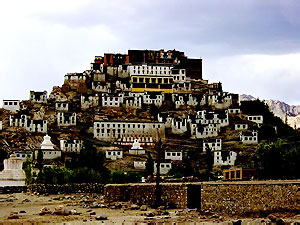 |
|
|
offers grand view of
the Sindh Valley below. The 12 storey monastery complex
contains numerous stupas, statues, Thangkas, wall paintings,
swords and a large pillar engraved with the Buddha's
teachings. The monastery has around 10 temples which are full
of interesting figures and other religious objects. Around100
monks of the yellow hat sect reside in this monastery. Just
after the main entrance one can see a large statue of Buddha.
This Buddha statue was constructed under the guidance of the
present local head lama. This statue is 15 meters tall and was
built in the year 1980. This statue of Buddha is the largest
Buddha figure in Ladakh which took four years to built. The
statue is made of clay and covered with gold paint. This
wonderful Buddha statue was made entirely by the local
craftsmen and represents Maitreya (the Buddha of future).
Thiksey is known for its beautiful murals. The walls of the
monastery is full with the religious figures, murals, Tibetan
calendars and with the wheel of life. There is also a prayer
room which contains many books, some of these books are
handwritten or painted. Block printing is a recent modern
addition to the hand written work. In the main prayer hall
there is a image of Sakyamuni (the past Buddha) with two
Bodhisattava. This image is one of the main attraction. On the
left hand one can see the image of the eleven- headed
Avalokitashwara (a form of Buddha). On the roof top of the
monastery there is a temple which can be visited only by men.
On the top floor there is also a library which contains
numerous volumes of Kangyur (Buddhas teaching) and Stangyur
(comments on Buddha's teaching) texts. Above the temple there
is a narrow room used as classroom of the school which also
belongs to the monastery. Main religious Lamas here are the
teachers who teach the children Buddhist religion and in
future some of the children would be selected to become lamas.
Earlier it was a tradition in Ladakh that the families would
donate one son, normally the elder one, to the local monastery
to become the lama. But, in these days, however due to the
impact of modern life this tradition has almost disappeared.
The Thiksey monastery community has a school which is run by
the monastery management. It not only includes the knowledge
of Buddhism but also other subjects including the computer are
taught. Children from poor families are provided free
education. The monastery also take care that the children and
other lamas have food as well as medical assistance.
Thiksey gustor (festival) is
held from 17th to 19th day of the 12th month. During the
festival, the religious dances are performed. These dances are
known as Cham or mask dances. These colourful Cham dances are
an important part of the Buddhist culture. In these dances,
important religious stories are told and the victory of good
over devil is celebrated. This is also an annual occasion for
the villagers to be together. These festivals are related to
other social activities like planning the marriages etc. The
festival of the Thiksy monastery takes place every year on the
ninth months of Tibetan calendar. Thiksey Monastery is also
known for making the Mandalas. At the Thiksey monastery, the
Lamas make Mandala three times in a year. Natural colours like
the powder of the crushed stones are used. The specialty of
the Thiksey Monastery is sand Mandala as it may take many days
to produce them and once finished they put the sand in the
water which symbolizes the cycle of life. |
|